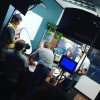This past school year, I had the honor and privilege of interning at Sparksight. Beginning this internship, I wasn’t sure what to expect. Would I be making coffee? Would I be the paperboy? Or worse, would I be fired on my first day of work? Well, the good thing is that the intern experience horror stories you read online might be true at other places, but not at Sparksight.
The tasks I’ve worked on ranged from video editing, to gripping, to shooting, to breaking down equipment. One of my first days, I filled the role of a grip on a small commercial shoot called Ignite Your Vision, an overview of the everything Sparksight brings to the table. What’s fascinating about being on a small shoot like that is the amount of effort it takes to nail down a consistent style. For example, the room that was used for many of the shots had production design equipment that moved between shots. Observing how the cinematographer added and subtracted the amount of light to hit the subject and keep the scene consistent from shot to shot was a great learning opportunity. Something I’ve struggled with in the past is having consistency from shot to shot, but being on set allows me to observe how other people do that, and take note of what I observe for future projects of mine.
Being thrown into a shoot like that on one of the first days was amazing, but what really stood out to me about this part of the intern experience was how energetic and efficient everyone was on set. It was refreshing working on a set with a distinct production direction and where you could clearly envision the end result as it was being produced.
In terms of post-processing, I had an understanding of programs such as Pro-Tools and Adobe Premiere Pro before hand. However, at Sparksight I learned little tricks that can take a project from one tier to the next. With my new skills, I was able to unlock new possibilities I never knew existed in the programs.
I was always curious about how to mix sound at the very end of a project to make it sound more professional. In my first project, Haymaker – Behind the Scenes Video, I was introduced to Pro Tools. In that short session, I learned how a program paired with the right knowledge can take a project from amateur to professional with relative ease. In the past I used Adobe Premiere Pro as the all-in-one program to sound mix my projects, but now that I know about the plug-ins that Pro Tools offers, I’ve never gone back.
While a student at the University of Texas, I worked on short form narrative and documentary projects. At Sparksight, I got to use my skills as a documentary editor, and apply them to different types of projects. As I spent more time in the intern experience, my editing pace quickened for all types of video, not just documentary.
It wasn’t always that easy though. The first time I was assigned a set of testimonial videos, I experienced a bit of a learning curve. There is a certain format for customer testimonials; introduction of the customer, explanation of their work and the service they offer, a short account of problem they had, and finally a spiel about how the product or service they use offers a solution to their problem.
While it sounds easy, it actually can be quite tough to find moments that fit that mold. All of the content is there in every video, but everyone has a different way of presenting their thoughts. Like documentary shorts, it’s all about finding the right moments that fit within a structure of the narrative. Once you have all the moments in your timeline, it just comes to molding the pacing of the piece. At the start of the year, Erich Reimers, a former intern and current employee, mentored me through a set of videos about the company Blackbaud. Having never edited this style of video before, Erich was able to guide me along the way as changes were implemented based on client feedback.
What I found enriching about this experience was getting an inside like at how the feedback loop works between Sparksight and their clients. In the past, I’ve done projects where I’ve received feedback and made changes based on those suggestions. The difference here was the client had timecode. This made post production much easier for us because the client would pick out the moments they liked the most allowing us to grab and edit those moments, to suit the client’s needs. Having this as an option saves so much time on both ends and allows for projects to have a quick turn around.
Sparksight was one of the first internships I had as a student at UT. When thinking about what I wanted from an intern experience, the idea of being paid for my work was near the top of my wish list. What’s great is that Sparksight pays their interns! That’s not to say I wouldn’t have taken the internship had it not been paid, but it was great working for a company who values their interns and their contributions to the company.
On top of that, they have been nothing but respectful towards my pursuit in academia. Never once did I feel as if I was unfairly treated or belittled, as I’ve heard some companies treat their interns. There were times during the school year when I needed time off in order to focus on my studies and projects, and they were always understanding of that. I am very grateful for the care that they had for me. Balancing school, the intern experience, and other commitments can be a massive undertaking. Because they were all students at one point in their lives too, they understood my position.
If I could go back and do my internship all over again, I would. I would recommend Sparksight to anyone who is looking to learn, gain experience, but more importantly, to work around people who are immensely supportive and always willing to help. Working in an environment where you can brainstorm, problem solve, and bounce ideas while always feeling supported and inspired, that’s special. That’s Sparksight.




